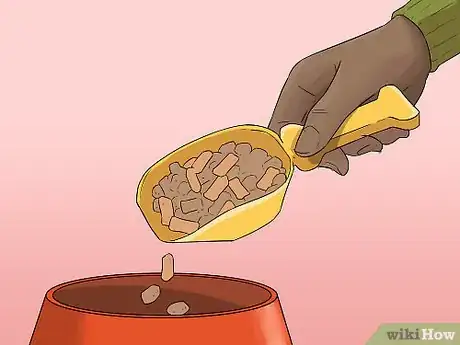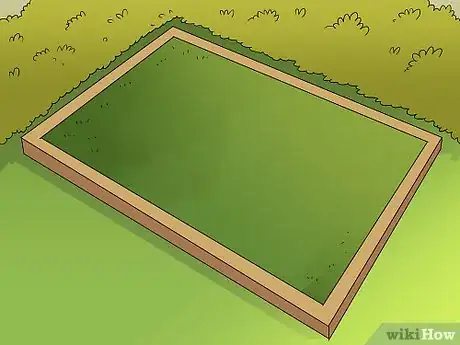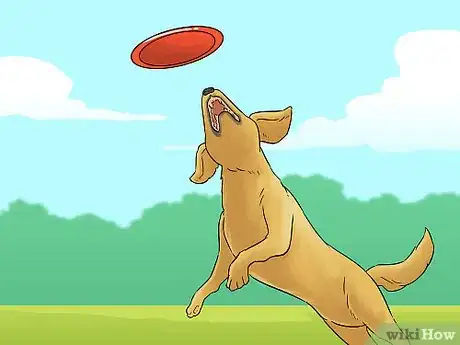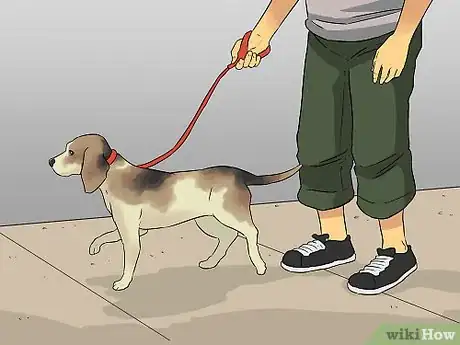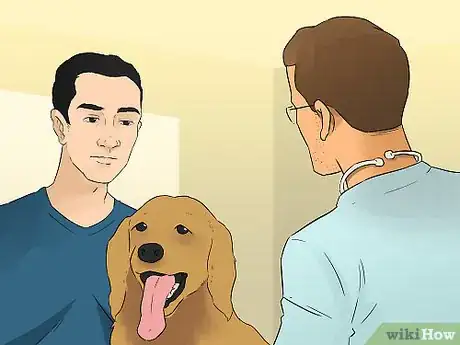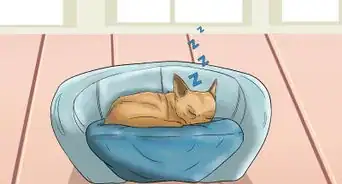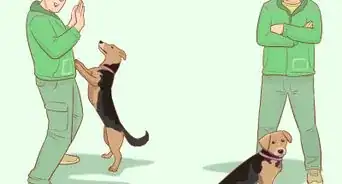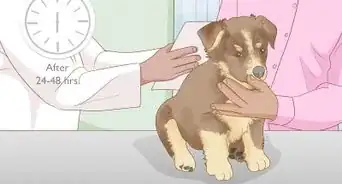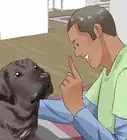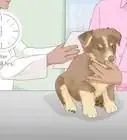This article was co-authored by Dee Hoult and by wikiHow staff writer, Hunter Rising. Dee Hoult is the CEO of Applause Your Paws, Inc., South Florida's largest privately-owned dog training company. With over 15 years of experience, Dee specializes in correcting dog behavior problems by providing engaging, positive education and non-intimidating training. Dee holds a BS in Marine Science and Biology and an MBA from the University of Miami. She is a credentialed Certified Professional Dog Trainer through the Certification Council for Professional Dog Trainers and a credentialed Certified Dog Behavior Consultant (CDBC) through the International Association of Applied Behavior Consultants (IAABC). In 2018, Dee was a finalist for Woman of the Year for the Women in the Pet Industry Awards.
There are 7 references cited in this article, which can be found at the bottom of the page.
This article has been viewed 77,508 times.
Having a steady routine will help shape your dog’s behavior, make training easier, and reduce the dog's stress levels. It can also help your dog adjust to being home alone, and it may even make it easier for you to spend time with your pet when you are home. Just stick to a consistent routine, including feeding and bathroom breaks, and watch how content your dog will become!
Steps
Making a Feeding Schedule
-
1Feed your dog at consistent times each day. Choose a time in the morning and evening when you’re home to feed your dog. Make sure to keep the time consistent so your dog knows when to expect their meal. Keeping your dog on a feeding schedule will help it develop a healthy metabolism and prevent it from begging for food at other times.[1]
- For example, feed your dog in the morning before you leave for work and again when you come home.
-
2Choose a place in your home where you’ll give your dog meals. Pick a quiet and comfortable area to keep your dog’s food bowl. Stand in the area with their bowl and ask your dog if it is hungry to train it to come to the spot at meal time.[2]
- Avoid doing any other activities with your dog in their meal area. That way, it’ll learn to go there only when it’s time to eat.
Advertisement -
3Set its food down for 5 to 10 minutes before picking it up again. When you’re ready to feed your dog, set its food bowl on the ground so it can eat. Regardless of if it eats or not, pick up the bowl and put it away after 5 to 10 minutes. This helps train your dog so it will eat whenever the bowl is on the floor.[3]
- If you leave food on the ground, your dog may leave some to nibble on throughout the day so it won't have a consistent routine.
Tip: If your dog doesn't eat when you set the bowl down, it may be a sign that it is sick. If your dog does not eat the next time either, schedule an appointment with your vet.
-
4Give your dog the same amount of food during each feeding. Use the same kind and amount of food whenever you feed your dog so it can develop a healthy metabolism. Significant changes to your dog’s diet could stress it out.[4]
- For example, don’t give your dog 2 scoops of food after a long day away if you normally give it 1 scoop on other days.
-
5Keep a bowl of water available for your dog at all times. Even though dog food should be kept on a set routine, dogs prefer to have access to water whenever they’re thirsty. Keep a bowl out and available throughout the day so your dog can drink when it needs to.[5]
- Change the water in your dog’s bowl every day.
- Clean the bowl every other day so bacteria can’t grow.
Setting an Outdoor Routine
-
1Let your dog outside after you wake up and before you sleep. Try to wake up at a consistent time each morning so your dog knows when it’s time to start the day and go outside. Keep it outside for 5 minutes before letting it back in. About 10 minutes before you go to bed, tell your dog it’s bedtime and let it out again for 5 minutes.[6]
- If your dog doesn’t go to the bathroom while it's outside, try bringing it in and keeping it in its crate or kennel for 2-3 minutes before letting it back out. This helps train your dog to relieve itself during the time it is outdoors.[7]
-
2Put your dog outside after it eats so it learns when to go to the bathroom. As soon as your dog has finished meal time, let it outside for 5 minutes so it knows it’s time to use the bathroom. Make sure your dog goes potty before you let it back inside.[8]
- Large adult dogs should be let outside at least once every 4-6 hours, and puppies should be taken out every 1-2 hours, or every 20 to 30 minutes when you are training a puppy to go potty outside.
-
3Play with your dog for 15-30 minutes each day. Even though your dogs will be less stressed while they’re on a routine, playing with them each day helps calm them down more. Throw a ball around for them to fetch, play Frisbee, or run around with them so they can burn off extra energy and spend quality time with you.[9]
- Make sure to differentiate between play and discipline. For example, use a stern voice when you’re telling your dog to drop something it shouldn’t have, but a playful voice when they’re fetching a ball.
Tip: On top of playing with toys outside, keep a selection of chew toys and bones that your dog can play with while it is inside as well.
-
4Take your dog for at least 1 walk a day at a consistent time. Taking your dog on walks allows them to get outside and interact with different environments. Let your dog sniff around while you’re walking so it can relax. Keep a consistent pace so your dog keeps walking rather than stopping every few feet.[10]
- If you don’t have the time to walk your dog, consider hiring a dog walking service to take the dog for you.
- Make sure your dog is up-to-date with its vaccines, or else it could be more susceptible to illnesses.
Altering Your Routine
-
1Change only 1 aspect of your dog’s routine at a time. Don’t try to make multiple changes to your routine all at the same time since it could stress your dog out. Instead, try to focus on 1 thing at a time so your dog gets used to them.[11]
- For example, if you’re going to move to a new home, don’t change your dog’s food or the schedule you’ve kept it on. Focus instead on getting your dog used to eating and living in a new place.
-
2Make gradual changes so your dog grows accustomed to them over time. A sudden change can cause your dog to get stressed and misbehave. Start by changing a small part of your routine, like feeding your dog 15 minutes earlier than usual or making your walks slightly shorter. Each week, make another small change so your dog has time to get used to its new schedule.[12]
- If you need to change your dog to a different food, start by mixing a little bit of their new food with the old food. Each meal, keep adding more of the new food until it completely replaces what it used to be eating.
-
3Have a friend or neighbor check on your dog if you’re going to be gone. If you know you’re going to be gone for most of the day, ask a friend or neighbor if they can help maintain your dog’s schedule. That way, your dog won’t get stressed from you being away and it’ll still have a consistent routine.[13]
- If you know you’re going to be away longer, such as going on a vacation, take your dog to a pet daycare so it can get the care and attention they need.
-
4Talk to a veterinarian if your dog develops behavioral issues. If you’re maintaining a regular routine with your dog but it is still acting out, take it to a veterinarian to discuss options. The vet may prescribe medication to help your dog destress and help with behavioral problems.[14]
Expert Q&A
-
QuestionWhere should puppies sleep at night?
 Dee HoultDee Hoult is the CEO of Applause Your Paws, Inc., South Florida's largest privately-owned dog training company. With over 15 years of experience, Dee specializes in correcting dog behavior problems by providing engaging, positive education and non-intimidating training. Dee holds a BS in Marine Science and Biology and an MBA from the University of Miami. She is a credentialed Certified Professional Dog Trainer through the Certification Council for Professional Dog Trainers and a credentialed Certified Dog Behavior Consultant (CDBC) through the International Association of Applied Behavior Consultants (IAABC). In 2018, Dee was a finalist for Woman of the Year for the Women in the Pet Industry Awards.
Dee HoultDee Hoult is the CEO of Applause Your Paws, Inc., South Florida's largest privately-owned dog training company. With over 15 years of experience, Dee specializes in correcting dog behavior problems by providing engaging, positive education and non-intimidating training. Dee holds a BS in Marine Science and Biology and an MBA from the University of Miami. She is a credentialed Certified Professional Dog Trainer through the Certification Council for Professional Dog Trainers and a credentialed Certified Dog Behavior Consultant (CDBC) through the International Association of Applied Behavior Consultants (IAABC). In 2018, Dee was a finalist for Woman of the Year for the Women in the Pet Industry Awards.
Certified Dog Behavior Consultant
-
QuestionDo dogs prefer routine?
 Dee HoultDee Hoult is the CEO of Applause Your Paws, Inc., South Florida's largest privately-owned dog training company. With over 15 years of experience, Dee specializes in correcting dog behavior problems by providing engaging, positive education and non-intimidating training. Dee holds a BS in Marine Science and Biology and an MBA from the University of Miami. She is a credentialed Certified Professional Dog Trainer through the Certification Council for Professional Dog Trainers and a credentialed Certified Dog Behavior Consultant (CDBC) through the International Association of Applied Behavior Consultants (IAABC). In 2018, Dee was a finalist for Woman of the Year for the Women in the Pet Industry Awards.
Dee HoultDee Hoult is the CEO of Applause Your Paws, Inc., South Florida's largest privately-owned dog training company. With over 15 years of experience, Dee specializes in correcting dog behavior problems by providing engaging, positive education and non-intimidating training. Dee holds a BS in Marine Science and Biology and an MBA from the University of Miami. She is a credentialed Certified Professional Dog Trainer through the Certification Council for Professional Dog Trainers and a credentialed Certified Dog Behavior Consultant (CDBC) through the International Association of Applied Behavior Consultants (IAABC). In 2018, Dee was a finalist for Woman of the Year for the Women in the Pet Industry Awards.
Certified Dog Behavior Consultant Generally, dogs do well with structure and routine. However, it's important not to get too much into routines because dogs need new experiences. Enjoy fun new things with your dog. Otherwise, it may develop some behavioral issues.
Generally, dogs do well with structure and routine. However, it's important not to get too much into routines because dogs need new experiences. Enjoy fun new things with your dog. Otherwise, it may develop some behavioral issues. -
QuestionWhat should I do if my dog doesn't want to 'do his business' while going out? I take it out 30 mins after meal time.
 Community AnswerYou can push the time for the walk back a bit (1 hour), or try a longer walk than you were planning. Just like us, they sometimes have to get the internal systems moving before they can go. He probably hasn't received the "signal" yet, so either giving him a bit more time before heading out, or taking a longer walk, or playing a game of fetch or tug-of-war in the yard or at the park (where he's having fun and running around) can get things stirred up. When walk time arrives, he's then more likely to be both able and very ready to "go."
Community AnswerYou can push the time for the walk back a bit (1 hour), or try a longer walk than you were planning. Just like us, they sometimes have to get the internal systems moving before they can go. He probably hasn't received the "signal" yet, so either giving him a bit more time before heading out, or taking a longer walk, or playing a game of fetch or tug-of-war in the yard or at the park (where he's having fun and running around) can get things stirred up. When walk time arrives, he's then more likely to be both able and very ready to "go."
References
- ↑ https://www.pets4homes.co.uk/pet-advice/dogs-and-routine-why-is-a-regular-routine-important.html
- ↑ https://www.pets4homes.co.uk/pet-advice/dogs-and-routine-why-is-a-regular-routine-important.html
- ↑ https://www.petfinder.com/dogs/dog-nutrition/dog-feeding-schedule/
- ↑ https://www.pets4homes.co.uk/pet-advice/dogs-and-routine-why-is-a-regular-routine-important.html
- ↑ https://www.petplace.com/article/dogs/pet-care/ideal-daily-schedule-for-dogs-and-puppies/
- ↑ https://www.pets4homes.co.uk/pet-advice/dogs-and-routine-why-is-a-regular-routine-important.html
- ↑ https://www.akc.org/expert-advice/advice/temporary-changes-in-routine/
- ↑ https://www.pets4homes.co.uk/pet-advice/dogs-and-routine-why-is-a-regular-routine-important.html
- ↑ https://www.animalwised.com/create-a-positive-daily-routine-for-your-dog-1432.html
- ↑ https://www.animalwised.com/create-a-positive-daily-routine-for-your-dog-1432.html
- ↑ https://www.pets4homes.co.uk/pet-advice/dogs-and-routine-why-is-a-regular-routine-important.html
- ↑ https://www.pets4homes.co.uk/pet-advice/dogs-and-routine-why-is-a-regular-routine-important.html
- ↑ https://www.akc.org/expert-advice/advice/temporary-changes-in-routine/
- ↑ https://www.akc.org/expert-advice/advice/temporary-changes-in-routine/
- ↑ Dee Hoult. Certified Dog Behavior Consultant. Expert Interview. 15 September 2020.
About This Article
To make a routine for your dog, take it outside to go to the bathroom after you wake up in the morning and before you go to sleep, which will help it get used to when your day starts and ends. You should also take your dog out to go to the bathroom after every meal so it learns when to go to the bathroom throughout the day. Also, try to feed your dog at consistent times every day so it doesn't beg for food, and make sure you take it out for at least 1 walk a day at a consistent time. For more tips from our Veterinary co-author, like how to switch up your dog's routine, scroll down!



